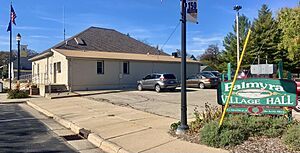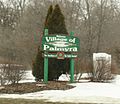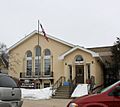Palmyra, Wisconsin facts for kids
Quick facts for kids
Palmyra, Wisconsin
|
|
|---|---|
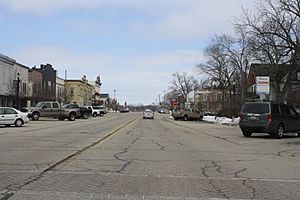
Looking east at downtown Palmyra
|
|
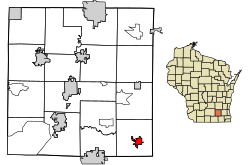
Location of Palmyra in Jefferson County, Wisconsin.
|
|
| Country | |
| State | |
| County | Jefferson |
| Government | |
| • Type | Village Board (President - Trustees) |
| Area | |
| • Total | 2.21 sq mi (5.71 km2) |
| • Land | 2.15 sq mi (5.58 km2) |
| • Water | 0.05 sq mi (0.13 km2) |
| Elevation | 850 ft (260 m) |
| Population
(2020)
|
|
| • Total | 1,719 |
| • Density | 815.31/sq mi (314.86/km2) |
| Time zone | UTC-6 (Central (CST)) |
| • Summer (DST) | UTC-5 (CDT) |
| Area code(s) | 262 |
| FIPS code | 55-61050 |
| GNIS feature ID | 1571003 |
Palmyra is a village in Jefferson County, Wisconsin, United States. It is located along the Scuppernong River. The village was named after the ancient desert city of Palmyra, Syria. This was because its soil was dry and sandy, much like an oasis. In 2020, about 1,719 people lived in Palmyra. The village is right next to the larger Town of Palmyra.
Contents
History of Palmyra
The Town of Palmyra was first created in 1846. Later, in 1876, a part of this town officially became the village of Palmyra.
Palmyra was once famous for its mineral springs. People believed these springs had healing powers. In 1870, the Palmyra Springs Sanitarium was built. A sanitarium was a place where people went to rest and get healthy. This large, four-story building was located by what is now Lower Spring Lake.
The sanitarium had many modern features for health and wellness. It offered different types of baths, like salt and Turkish baths. There was also a big gym, a theater, and places for music and games. Outside, a 40-acre forest had walking paths. This forest is now part of the Southern Kettle Moraine State Forest.
A large spring, called the Aurelian Spring or Big Blue Spring, was nearby. It was 50 feet wide and 38 feet deep. Its clear, blue water was thought to be very good for health. A dam was later built, forming what is now Blue Spring Lake.
In 1924, the sanitarium became a home for older pharmacists. However, people soon lost interest in the mineral treatments. The facility closed down a few years later. In the late 1950s, the building was taken down, and the land was leveled.
Palmyra's Geography
Palmyra is located at coordinates 42°52′37″N 88°35′13″W.
The village covers a total area of about 1.25 square miles (3.24 square kilometers). Most of this area, about 1.20 square miles (3.11 square kilometers), is land. The rest, about 0.05 square miles (0.13 square kilometers), is water.
Palmyra's Population
The population of Palmyra has changed over the years. Here is a look at how many people have lived there:
| Historical population | |||
|---|---|---|---|
| Census | Pop. | %± | |
| 1870 | 703 | — | |
| 1880 | 598 | −14.9% | |
| 1890 | 567 | −5.2% | |
| 1900 | 716 | 26.3% | |
| 1910 | 649 | −9.4% | |
| 1920 | 685 | 5.5% | |
| 1930 | 642 | −6.3% | |
| 1940 | 711 | 10.7% | |
| 1950 | 862 | 21.2% | |
| 1960 | 1,000 | 16.0% | |
| 1970 | 1,341 | 34.1% | |
| 1980 | 1,515 | 13.0% | |
| 1990 | 1,540 | 1.7% | |
| 2000 | 1,766 | 14.7% | |
| 2010 | 1,781 | 0.8% | |
| 2020 | 1,719 | −3.5% | |
| U.S. Decennial Census | |||
2010 Census Information
In 2010, there were 1,781 people living in Palmyra. These people lived in 704 households. About 469 of these households were families. The village had about 1,484 people per square mile (573 people per square kilometer).
Most people in the village, about 94.7%, were White. Other groups included African American (0.6%), Native American (0.5%), and Asian (0.2%). About 10.3% of the population identified as Hispanic or Latino.
In 2010, about 35.1% of households had children under 18 living there. About 51.0% of households were married couples. The average household had 2.53 people, and the average family had 3.04 people.
The average age in the village was 37.2 years old. About 25.4% of residents were under 18. About 12.9% were 65 years or older.
Notable People from Palmyra
Many interesting people have connections to Palmyra:
- Hiram J. Ball – A farmer and Wisconsin state legislator.
- Justin Beaver – A college football player for the University of Wisconsin-Whitewater.
- Gary Congdon – A racing car driver.
- Susan Hawk – A contestant on the first season of the TV show Survivor.
- Adoniram J. Holmes – A congressman from Iowa.
- Knute Nelson – A U.S. senator from Minnesota.
- Iva Bigelow Weaver – A singer and music teacher from Milwaukee.
- Frederick L. Wieseman – A U.S. Marine Lieutenant general.
Images for kids
See also
 In Spanish: Palmyra (Wisconsin) para niños
In Spanish: Palmyra (Wisconsin) para niños


